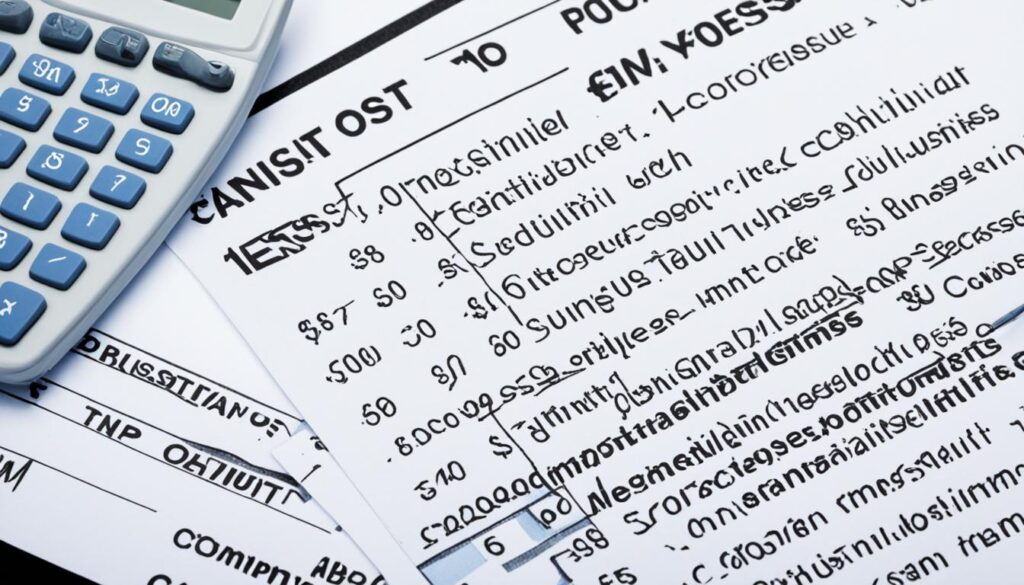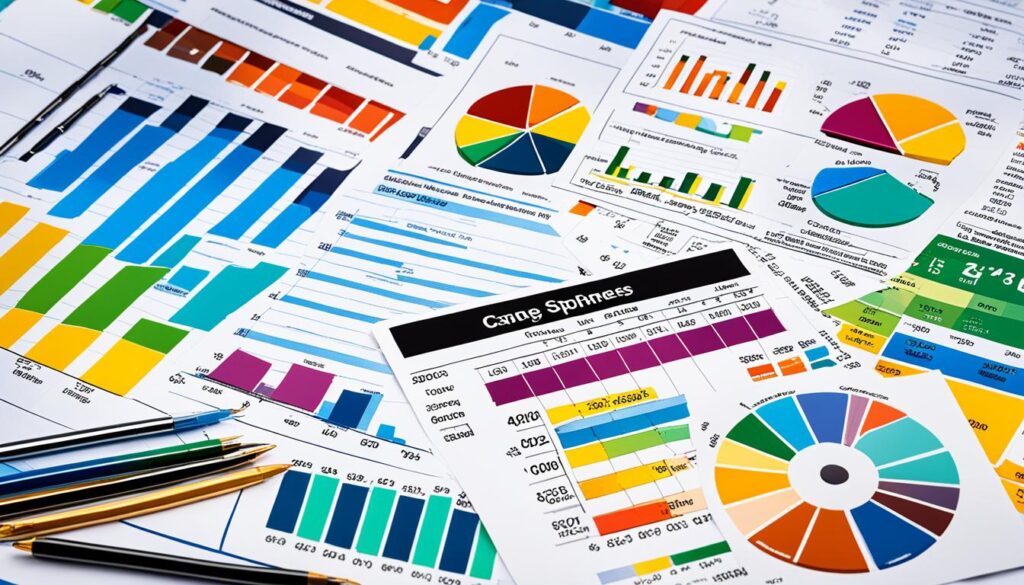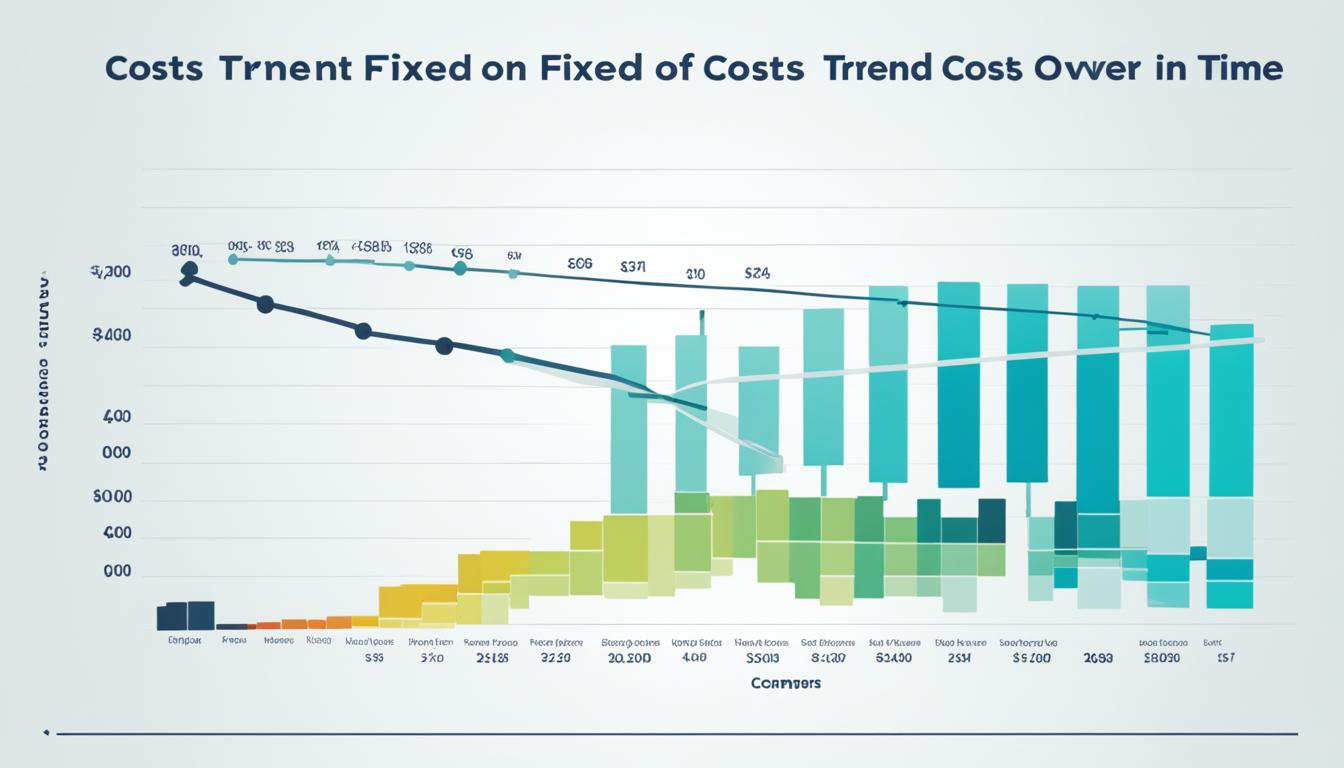Did you know that fixed costs can account for up to 50% or more of a business’s total expenses?
Fixed costs, also known as business fixed overhead expenses, are the expenses that remain constant regardless of the level of business activity. These costs include things like rent, salaries, insurance, and utilities. While variable costs fluctuate with sales volume, fixed costs remain steady, making them a critical component of managing business expenses.
Key Takeaways:
- Fixed costs are independent of sales volume and remain constant regardless of business activity.
- Examples of fixed costs include rent, salaries, insurance, and utilities.
- Understanding fixed costs is crucial for optimizing business profitability.
- Effective management of fixed costs involves strategies like renegotiating lease agreements and streamlining operations.
- Conducting a break-even analysis helps determine the minimum sales volume needed to cover all costs.
The Difference Between Fixed Costs and Variable Costs
Fixed costs and variable costs play distinct roles in determining a business’s profitability. Understanding the differences between these two types of costs is crucial for making informed decisions and optimizing financial performance.
Fixed costs are expenses that remain constant regardless of the level of business activity. They are the essential overhead expenses that a business incurs even when there are no sales. Examples of fixed costs include rent, salaries, insurance, and equipment maintenance.
Variable costs, on the other hand, fluctuate based on the level of business activity. These costs are directly tied to the production or sale of goods and services. Examples of variable costs include raw materials, direct labor, and sales commissions.
The main distinction between fixed costs and variable costs lies in their behavior in relation to sales volume. Fixed costs, as the name implies, remain unchanged regardless of sales volume. They are incurred independent of business activity and need to be covered by the revenue generated from sales.
Variable costs, on the other hand, vary in direct proportion to sales volume. As sales increase, variable costs increase, and vice versa. These costs are directly tied to the production or sale of each unit and are typically expressed as a cost per unit.
“Fixed costs, such as rent and salaries, remain the same regardless of sales volume.”
The impact of fixed costs and variable costs on business profitability is significant. While fixed costs provide stability and are necessary for the business to operate, they can also create a financial burden if the business fails to generate sufficient revenue to cover these costs. Variable costs, on the other hand, directly affect the cost of goods sold and profitability. Managing variable costs effectively can help improve profit margins and overall business performance.
By understanding the differences between fixed costs and variable costs, businesses can make strategic decisions regarding pricing, production levels, and cost reduction strategies. A balanced cost structure that optimizes fixed costs while effectively managing variable costs is key to maximizing profitability.
In the next section, we will explore some examples of fixed costs in business. Understanding these examples will provide further insights into the impact of fixed costs on different industries and operations.
Examples of Fixed Costs in Business
Fixed costs are an integral part of running a business and can vary across different industries. They are ongoing expenses that remain constant regardless of business activity. Here are some common examples of fixed costs:
- Rent or mortgage payments: The cost of leasing or owning a space for business operations.
- Property taxes: Taxes imposed on the property used for business purposes.
- Interest payments: The interest accrued on loans or financing used for business investments.
- Depreciation of assets: The gradual decrease in value of assets over time.
- Insurance: Premiums paid to protect the business against potential risks and liabilities.
- Salaries: The regular payments made to employees for their services.
These fixed costs are essential for the day-to-day functioning of a business and are incurred irrespective of sales volume or customer demand.
| Industry | Examples of Fixed Costs |
|---|---|
| Restaurant | Rent, utilities, insurance |
| Retail | Store rent, property taxes, salaries |
| Manufacturing | Factory rent, equipment depreciation, insurance |
| Professional Services | Office rent, professional insurance, salaries |

In different industries, specific types of fixed costs may vary depending on the nature of the business. For example, a restaurant owner would have fixed costs like rent, utilities, and insurance, while a graphic designer working from a home office may have fixed costs like computer equipment and web hosting. Understanding the different types of fixed costs in your industry is crucial for effectively managing expenses and optimizing business profitability.
Examples of Variable Costs in Business
Variable costs are an integral part of a business’s expenses as they directly correlate with sales volume and production levels. Understanding the common types of variable costs can help businesses make informed decisions when managing their expenditures and optimizing profitability.
Here are some examples of variable costs that businesses commonly encounter:
- Direct Materials: These are the raw materials or components used in the production process. The cost of direct materials varies based on the quantity and price per unit. For example, a bakery’s variable cost of flour would increase as the volume of baked goods produced increases.
- Production Supplies: These include items needed for day-to-day operations, such as packaging materials, cleaning supplies, and maintenance tools. The consumption of these supplies fluctuates depending on production levels. For instance, a manufacturing company’s variable cost of packaging materials would rise as the number of products manufactured increases.
- Sales Commissions: Businesses that rely on sales representatives often incur variable costs in the form of commissions. The amount paid to salespeople varies based on their performance and the volume of sales generated. Companies typically set commission rates as a percentage of the sales value.
- Credit Card Fees: When customers make purchases using credit cards, businesses incur transaction fees from credit card companies. These fees are typically a percentage of the transaction amount and can vary based on the type of card used and the total volume of credit card sales.
- Delivery Charges: For businesses that deliver products to customers, variable costs include expenses related to shipping, transportation, and logistics. The cost of delivery services can vary based on factors such as distance, package weight, and the number of deliveries made.
It’s important to note that the specific types and amounts of variable costs can vary across different industries. A restaurant owner, for example, would incur variable costs like food ingredients, beverages, and wages for non-salaried employees. In contrast, a manufacturing firm would have variable costs such as raw materials and packaging supplies.

Managing and Reducing Fixed Costs
Effective management of fixed costs is crucial for optimizing business profitability. By implementing strategies to reduce fixed costs, businesses can enhance their financial health and maintain a competitive edge in the market. Here are some key approaches to managing fixed costs:
1. Renegotiating Lease Agreements
One way to reduce fixed costs is by renegotiating lease agreements. Businesses can approach landlords or property owners to negotiate lower rent rates or seek more favorable terms. Renegotiating leases can result in significant cost savings, helping businesses allocate resources more efficiently.
2. Exploring Cost-Sharing Options
Collaborating with other businesses or organizations to share certain expenses is another effective strategy for reducing fixed costs. This can include sharing office spaces, equipment, or even employee costs. By sharing expenses, businesses can reduce their individual financial burden and achieve cost optimization.
3. Implementing Energy-Saving Measures
Investing in energy-saving measures can lead to substantial cost reductions over time. Businesses can upgrade to energy-efficient equipment, optimize lighting systems, and improve insulation to lower utility expenses. By minimizing energy consumption, businesses can effectively manage and reduce fixed costs related to utilities.
4. Streamlining Operations to Reduce Labor Costs
Streamlining operations and optimizing workforce productivity is vital for managing fixed costs. Effective scheduling, cross-training employees, and utilizing technology can increase efficiency and reduce labor expenses. By eliminating unnecessary tasks and optimizing the workforce, businesses can achieve significant savings on fixed costs associated with wages and salaries.
Regularly reviewing fixed costs and identifying areas for cost reduction is essential for maintaining financial health. By implementing these cost-cutting techniques, businesses can enhance profitability and ensure long-term success.
The Importance of Cost Structure and Break-Even Analysis
Understanding cost structure and conducting a break-even analysis is essential for determining the profitability of a business. Cost structure analysis involves examining the distribution of fixed and variable costs in a business to gain insights into its financial viability.
Cost structure analysis helps businesses evaluate their pricing strategies by understanding how costs are allocated between fixed and variable components. By analyzing the cost structure, businesses can determine the volume of sales needed to break even, make informed decisions about cost management, and assess the impact of cost changes on profitability.
Break-even analysis, on the other hand, is a financial tool that allows businesses to calculate the point at which total revenue equals total costs, resulting in neither profit nor loss. It determines the minimum level of sales needed to cover all costs and start generating profit.
Cost structure analysis and break-even analysis provide valuable insights into business profitability by considering both fixed and variable costs. They help business owners set realistic sales targets, make informed pricing decisions, and assess the financial impact of changes in cost structure.
Benefits of Cost Structure and Break-Even Analysis
Cost structure analysis and break-even analysis offer several benefits for businesses:
- Understanding Profitability: By analyzing the cost structure and conducting break-even analysis, businesses can determine their profitability and identify areas for improvement.
- Optimizing Pricing Strategies: Cost structure analysis helps businesses evaluate their pricing strategies by assessing the impact of cost changes on profitability. It ensures that prices are set to cover both fixed and variable costs, ultimately leading to higher profitability.
- Identifying Cost Management Opportunities: Cost structure analysis enables businesses to identify areas where they can reduce costs and improve efficiency. By understanding the distribution of costs, businesses can develop strategies to manage fixed and variable costs effectively.
- Setting Realistic Sales Targets: Break-even analysis helps businesses set realistic sales targets by determining the minimum level of sales needed to cover all costs. It guides business owners in planning and forecasting for growth.
By leveraging cost structure analysis and break-even analysis, businesses can make informed decisions about pricing, cost management, and sales targets to improve their profitability and long-term success.
| Fixed Costs in Breakeven Analysis | Variable Costs in Breakeven Analysis |
|---|---|
| Rent or mortgage payments | Direct materials |
| Salaries | Production supplies |
| Insurance | Sales commissions |
| Depreciation of assets | Credit card fees |
| Interest payments | Delivery charges |
Conclusion
Managing and optimizing fixed costs is crucial for maintaining the financial health and profitability of your business. As an entrepreneur, it is essential to understand the differences between fixed costs and variable costs to make informed decisions about cost management and pricing strategies. By effectively managing your fixed costs, you can minimize unnecessary expenses and maximize your business’s profitability.
Implementing cost reduction strategies is key to optimizing business costs. One strategy is renegotiating lease agreements to secure more favorable terms and potentially lower rental costs. Exploring cost-sharing options with other businesses can also help distribute expenses and reduce individual burdens. Streamlining operations and improving efficiency can lead to cost savings by minimizing labor costs and reducing wastage.
Furthermore, conducting a break-even analysis can provide valuable insights into your business’s financial health. By determining the minimum sales volume required to cover all costs, you can set achievable targets and make informed decisions about pricing and sales strategies. This analysis considers both fixed and variable costs to ensure comprehensive cost management.
By implementing cost reduction strategies and effectively managing your fixed costs, you are positioning your business for long-term success and maximizing profitability. Remember to regularly review your expenses, identify areas for improvement, and adjust your strategies accordingly. With careful attention to cost optimization, you can drive your business towards greater financial stability and success.
FAQ
What are fixed costs of running a business?
Fixed costs, also known as business fixed overhead expenses, are independent of sales volume and include expenses like rent, salaries, and insurance. They remain constant regardless of business activity.
What is the difference between fixed costs and variable costs?
Fixed costs, such as rent and salaries, remain the same regardless of sales volume. They are independent of business activity. On the other hand, variable costs, like raw materials and commissions, change as sales volume changes. They directly depend on business activity.
What are some examples of fixed costs in business?
Some common examples of fixed costs include rent or mortgage payments, property taxes, interest payments, depreciation of assets, insurance, and salaries. The specific types of fixed costs may vary depending on the nature of the business.
What are some examples of variable costs in business?
Some common examples of variable costs include direct materials, production supplies, sales commissions, credit card fees, and delivery charges. These costs are directly related to business activity and increase or decrease as sales volume changes.
How can I manage and reduce fixed costs?
Strategies for managing fixed costs include renegotiating lease agreements, exploring cost-sharing options, implementing energy-saving measures, and streamlining operations to reduce labor costs. Regularly reviewing fixed costs and identifying areas for cost reduction can also help improve the financial health of the business.
Why is cost structure analysis and break-even analysis important?
Cost structure analysis helps businesses evaluate their pricing strategies, determine the volume of sales needed to break even, and make informed decisions about cost management. Break-even analysis calculates the minimum level of sales needed to cover all costs, considering both fixed and variable costs.


